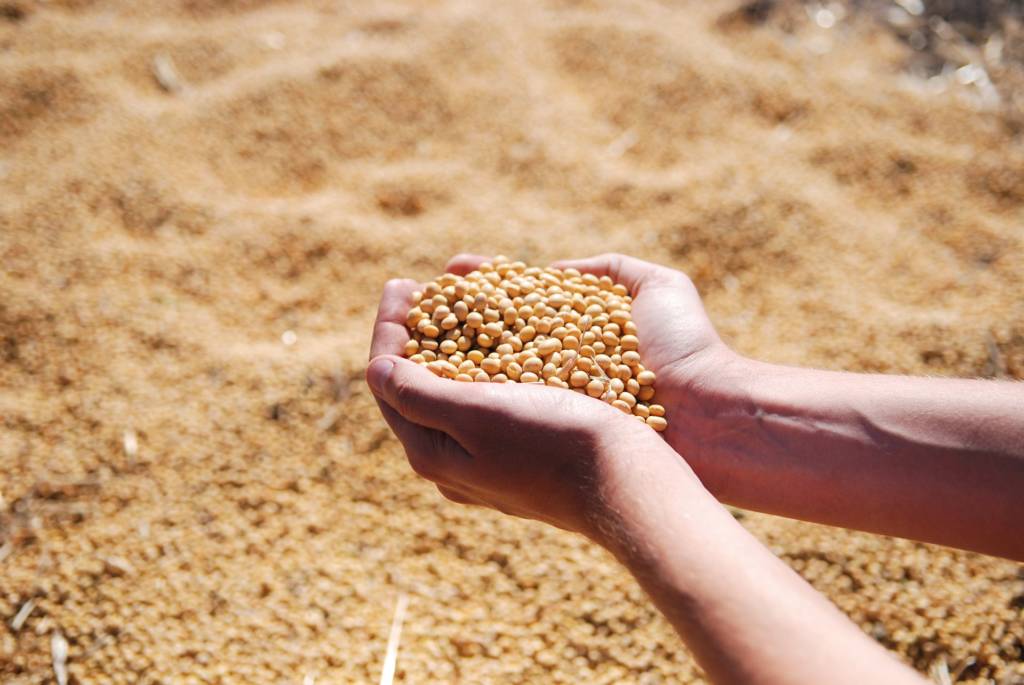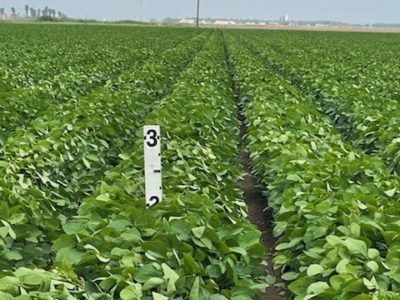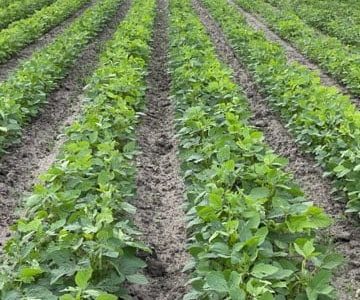U.S. Soy is committed to delivering high-quality U.S. soybeans efficiently to our customers. It requires a big effort and connecting many dots to get those soybeans from our fields to our customers. As a farmer, a grain merchandiser, and a volunteer soybean industry leader, I have a unique perspective on that process.
My family runs Garcia Grain Trading, an independent grain handling and exporting business based in Donna, Texas, in the Rio Grande Valley. The Lower Rio Grande Valley of Texas is a mild, sub-tropical region that allows for farming year-round. The main crops include cotton, sorghum, corn, sugarcane, vegetables and citrus fruit. The region includes 12 international bridge crossings, and our headquarters are also located about 245 km, or 150 miles, from the port of Corpus Christi, Texas, and roughly the same distance from Monterrey, Mexico, which allows for trade and commerce to flourish.

My dad started out as a farmer, but in the 1990s, he established Garcia Grain Trading, shipping dry edible beans to Mexico with guidance from merchandisers in the central and northern plains of the U.S. who became his mentors.
Over the years, Garcia Grain Trading has grown to include six grain elevators in the Lower Rio Grande Valley. We own about 1,215 hectares, or 3,000 acres, that we lease to area farmers. We work closely with these and other farmers in our region, providing agronomic support, setting up contracts with customers, and purchasing crops to merchandise. Today we export soybeans, corn, canola, rice, sorghum, sesame and more. Though we primarily serve customers in Mexico because of our proximity, we also export to Japan and China.
I joined the family business when I graduated from college. Using the skills and talents of my parents, sisters, aunt, cousins and uncles, it is a truly a family business. I enjoy understanding commodity markets, the supply chain, and figuring out how to help our farmers thrive. It is a privilege to serve the U.S. soybean industry as a board member for the American Soybean Association, where I am lucky enough to be surrounded by consummate professionals who are unrivaled in their experience and passion for soybeans.
New Varieties Fill Export Gap
Mexico is the No. 2 customer for U.S. soybeans, and their buying patterns show their preference. In 2020, the U.S. had an 85% market share in Mexico’s imports of whole soybeans, according to U.S. Department of Agriculture (USDA) data. Through much of the year, shuttle trains carry soybeans to crushing plants, including one of our customers in Monterrey. We also deliver soybeans grown in Texas to buyers in Mexico, which account for just a small percentage of their purchases. Most of the soybeans we export from the Texas Coastal Plain along the Gulf of Mexico between Corpus Christi and Houston.
But as U.S. soybean supplies tighten in July and August, these Mexican customers have to turn to South American imports to keep their crushing plants running at capacity. This gap presents an opportunity for both farmers in our area of South Texas and our customers in Mexico.
 Garcia Grain Trading is stepping into that gap, partnering with soybean breeders Andy Scott of Winecup Consulting in Hidalgo County, Texas, and Dr. Grover Shannon and Dr. Pengyin Chen of the University of Missouri. Together, we are working to develop soybean varieties that can be grown in South Texas, producing yields comparable to the U.S. average.
Garcia Grain Trading is stepping into that gap, partnering with soybean breeders Andy Scott of Winecup Consulting in Hidalgo County, Texas, and Dr. Grover Shannon and Dr. Pengyin Chen of the University of Missouri. Together, we are working to develop soybean varieties that can be grown in South Texas, producing yields comparable to the U.S. average.
With our sub-tropical climate, we can plant soybeans in late February or early March and harvest them in July and August, filling the supply gap of our Mexican customers exactly when they need additional supply. However, current available varieties will not perform consistently in our region. We want to change that and find soybean varieties. that can perform consistently for our South Texas producers.
 “Our latitude is near 26°N,” Scott said. “This region needs soybeans adapted to short days.” Scott collaborated with other plant breeders for many years in an effort to develop varieties for the Lower Rio Grande Valley. He also has a small farm in the Monte Alto, Texas, area and serves as a director on the United Soybean Board.
“Our latitude is near 26°N,” Scott said. “This region needs soybeans adapted to short days.” Scott collaborated with other plant breeders for many years in an effort to develop varieties for the Lower Rio Grande Valley. He also has a small farm in the Monte Alto, Texas, area and serves as a director on the United Soybean Board.
Developing Unique Soybeans
Soybeans use the amount of light they get during the day to determine when to shift from vegetative to reproductive growth and start flowering. We classify soybeans by maturity groups based on their response to day length to know how long they need from planting to maturity. But when we try to grow soybean varieties from any maturity group under our short days, they start reproductive stages before the plants are big enough to yield well, as this photo shows.
“Through years of public soybean breeders’ research, a wild soybean variety from the Philippines showed a uniquely different trait in response to day lengths that defies maturity groupings,” Scott said. “It allows the plant to grow vegetatively for 50 to 60 days before switching to reproductive growth phases. I call it delayed flowering, and these novel genetics allow soybeans to potentially be produced all the way to the equator.”
He has said that these unique soybeans have been classified as “delayed flowering under short-day conditions” or “long-juvenal” varieties because of their vegetative growth.
 The breeding process created other challenges, though. The breeders made crosses to capture the glyphosate-tolerant herbicide trait desired by farmers that Scott evaluated for adaptability under Lower Rio Grande Valley conditions. They had to balance the delayed flowering trait with the ability for the pods to hold mature soybeans until harvest, rather than shattering as soon as they reached maturity. They also bred in tolerance to salt, as the irrigation water from the Rio Grande used in our area has a high salt content.
The breeding process created other challenges, though. The breeders made crosses to capture the glyphosate-tolerant herbicide trait desired by farmers that Scott evaluated for adaptability under Lower Rio Grande Valley conditions. They had to balance the delayed flowering trait with the ability for the pods to hold mature soybeans until harvest, rather than shattering as soon as they reached maturity. They also bred in tolerance to salt, as the irrigation water from the Rio Grande used in our area has a high salt content.
The long-juvenal varieties he has been working on show a lot of promise for farmers in South Texas.
“After years of breeding, we’ve developed a couple of soybean varieties that have an extended vegetative phase that allows them to grow enough to make yields equal to or greater than the U.S. national average,” Scott said. “Last year one of our varieties yielded about 5 metric tons per hectare, or 74.6 bushels per acre in commercial fields.”
2021 Soybean Crop Progress
Garcia Grain Trading contracted with farmers to grow about 810 hectares or 2,000 acres of two new glyphosate-tolerant varieties, Pamela GT and Lynda GT, this spring. We have seed storage facilities as part of our business, which allows us to help store and deliver soybean seeds to farmers and provide another crop option for them.
 When planted in early spring – late February or early March – the new varieties act like maturity group 4 soybeans, which are typically planted in Delaware, Maryland, Virginia, Kentucky and across the southern Midwest U.S.
When planted in early spring – late February or early March – the new varieties act like maturity group 4 soybeans, which are typically planted in Delaware, Maryland, Virginia, Kentucky and across the southern Midwest U.S.
The soybeans planted this spring are looking really good, so far, despite some challenges. We had to wait until after the hard freeze we experienced in mid-February to plant. And, we have drought conditions, receiving only 2.5 cm, or 1 inch, of moisture since October. Irrigation has helped their growth, and we expect these soybeans to flower the last week of April. They should be ready to harvest in July or August, and we will export them to a crushing plant in Monterrey.
These soybeans can be double-cropped following harvest of the first crop in July or early August. When planted between mid-July and mid-August, these soybeans behave like maturity group 9 varieties, which are typically planted in sub-tropical climates like central Brazil. They can be harvested in November or December. However, in general seed yields are 30 to 40% less than spring plantings.
Developing soybean varieties adapted to the short days in our area is an exciting project for my family. We are proud to use our resources to provide new opportunities for our farmers and meet the needs of our customers. We are just one example of a link in the U.S. soybean supply chain.
I will share updates on this crop throughout the 2021 growing season here on USSoy.org. I also will share more of my unique perspective as the link between U.S. soybean farmers and our global customers.



